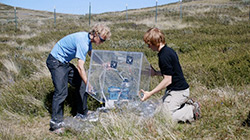Sean Cahoon, ENRI graduate student researcher publishes article on carbon cycles
by Kathleen McCoy |
Sean Cahoon, a 2010 UAA M.S. in Biological Sciences graduate and Environment and Natural Resources Institute (ENRI) graduate student researcher, had a research article published in the December 2010 issue of Global Glimpses, the newsletter of UAF's Center for Global Change & Arctic System Research.
 Cahoon's article, titled "Caribou and Muskoxen Mediate Carbon Cycle Responses to Climate
Change in West Greenland," was the result of his master's research at UAA. Cahoon's
research focused on the relationships between global warming, carbon cycle processes
and the impact of large herbivores (caribou and muskoxen) on the Arctic environment
of western Greenland.
Cahoon's article, titled "Caribou and Muskoxen Mediate Carbon Cycle Responses to Climate
Change in West Greenland," was the result of his master's research at UAA. Cahoon's
research focused on the relationships between global warming, carbon cycle processes
and the impact of large herbivores (caribou and muskoxen) on the Arctic environment
of western Greenland.
Arctic terrestrial environments can serve as either carbon sources or as carbon sinks. Ecosystems which act as carbon sources give off more carbon into the atmosphere from respired carbon dioxide (CO2) than they remove through photosynthesis. Ecosystems which act as carbon sinks take in more carbon from the atmosphere through photosynthesis than they give off through respiration of CO2. Scientists are interested in the responses of the Arctic to global warming because these responses may either mitigate (by acting as carbon sinks) or add to (by acting as carbon sources) the effects of global warming.
Cahoon's research project was part of a NSF-funded research project led by UAA Environment
and Natural Resources Institute (ENRI) researchers Dr. Jeff Welker (PI) and Dr. Paddy
Sullivan (co-PI) and Pennsylvania State University researcher Dr. Eric Post. This
research project had two areas of focus:
(1) the effects of global warming on carbon cycle relationships within an Arctic ecosystem;
and (2) the effects of large herbivores (muskoxen and caribou) on the vegetation of
the Arctic ecosystem, and the resulting effects on carbon cycle relationships.
The research site near Kangerlussuaq contains exclosure fences erected in 2002; passive simulated warming devices (open-top chambers), both within and outside the exclosure fences, dating to 2003; and control plots both within and outside the exclosure fences. The project has demonstrated that large herbivores have a dramatic effect on the vegetation within an Arctic ecosystem: inside the exclosure areas, shrubs such as dwarf birch and gray willow predominate; outside the fences, where muskoxen and caribou are allowed to graze, meadowgrasses are the most prevalent vegetation.
Using a portable photosynthesis system, Cahoon measured changes in CO2 values. He correlated these measurements with Leaf Area Index (LAI) data to determine relationships between vegetation types and photosynthesis and respiration levels.
Cahoon's research found that the exclusion of large herbivores from Arctic terrestrial ecosystems leads to: a significant net increase in carbon (CO2) uptake (carbon sink); a predominance of shrubs, which leads to increased LAI values; and increased ecosystem photosynthesis. In addition, Cahoon found that: warming did not increase ecosystem respiration but did increase ecosystem photosynthesis; and, since shrub leaves tend to be darker in color than meadowgrasses, they reduce the amount of light reflected from incoming radiation and therefore lower surface temperatures.
Cahoon's research adds significantly to the understanding of Arctic ecosystems' responses to global warming. The experimental warming of this Arctic terrestrial ecosystem did not, in itself, lead to significant changes in carbon cycle relationships. However, the presence or absence or large herbivores affected carbon cycle relationships significantly by determining the vegetative makeup of the ecosystem. Cahoon is now pursuing his Ph.D. at Pennsylvania State University.
Read the full article as a PDF here.
 "Sean Cahoon, ENRI graduate student researcher publishes article on carbon cycles" is licensed under a Creative Commons Attribution-NonCommercial 4.0 International License.
"Sean Cahoon, ENRI graduate student researcher publishes article on carbon cycles" is licensed under a Creative Commons Attribution-NonCommercial 4.0 International License.









